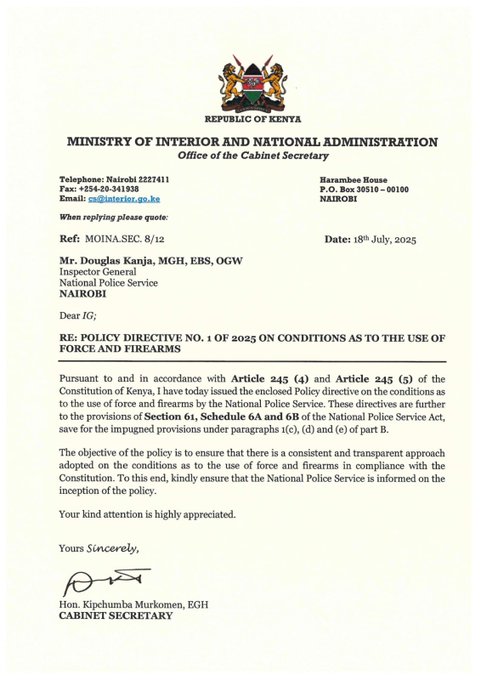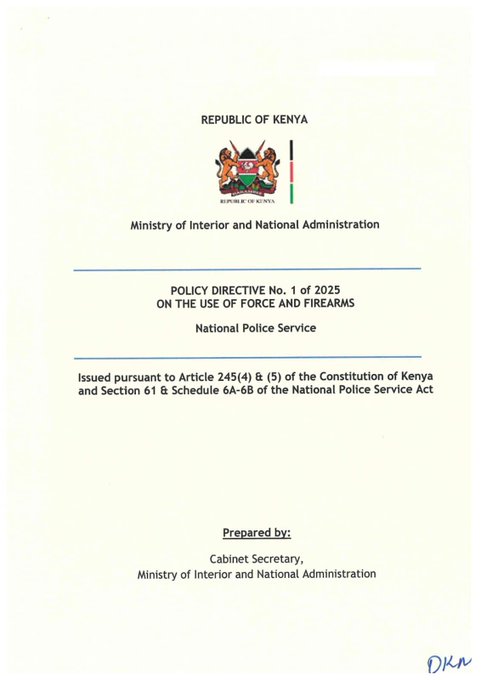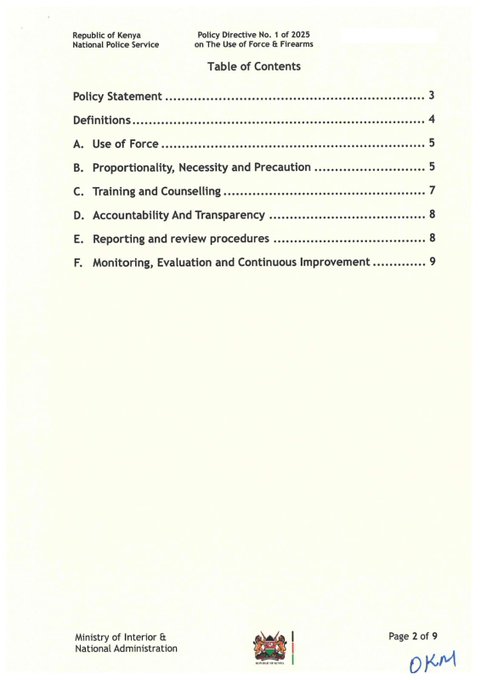NAIROBI, Kenya — Interior and National Administration Cabinet Secretary Kipchumba Murkomen has issued a sweeping new directive to guide police officers on the use of force and firearms, marking his first major policy move since taking office.
The directive, addressed to Inspector General of Police Douglas Kanja, aims to establish clear national standards for the National Police Service (NPS) in line with the Constitution, the NPS Act, and relevant court decisions.
Murkomen said the policy seeks to enhance transparency, accountability, and public trust in law enforcement.
“This directive sets the standard for when and how force may be applied, ensuring it remains lawful, necessary, proportionate, and used only as a last resort,” the CS said Friday.
No Force After Arrest, Firearms Only in Life-Threatening Cases
According to the policy, police officers may only use force when necessary, and even then, only to the extent required to perform their duties.
Using force as punishment or after a suspect has been safely detained is expressly prohibited.
Firearms are to be used only in situations involving a direct threat to life or serious injury, and when no lesser means are available.
Any such incident must be reported to the Independent Policing Oversight Authority (IPOA) without delay.
POLICY DIRECTIVE NO. 1 OF 2025 ON CONDITIONS AS TO THE USE OF FORCE AND FIREARMS BY POLICE
Modern Tools and De-escalation Emphasized
To promote operational transparency, Murkomen’s directive calls for the adoption of modern technologies, including body-worn cameras, fixed CCTV systems, and digital evidence-capture tools.
The directive also mandates that officers prioritize de-escalation strategies and undergo regular training on conflict resolution, mental wellness, and human rights.
Officers will be screened and evaluated periodically for their ethical, mental, and physical readiness.
The National Police Service Commission is expected to integrate these assessments into ongoing recruitment and capacity-building programmes.
Protection of Peaceful Protesters
The policy offers new clarity on how police should manage public demonstrations.
It instructs officers not to use force when dispersing unlawful but non-violent assemblies and instead prioritize dialogue and restraint.
In cases where force is unavoidable, it must be minimal and strictly regulated.
Officers are further instructed to protect peaceful protesters from attacks or interference by third parties — as guaranteed under Article 37 of the Constitution.
Special care is mandated when handling vulnerable groups, including children, the elderly, and persons with disabilities.
Accountability and Independent Oversight
To support oversight, a centralized data system will be established to monitor all reportable use-of-force incidents, training completion rates, public complaints, and related metrics.
Officers accused of misconduct in such cases will be subject to independent investigations, in accordance with Section 24, Part III of the IPOA Act.
However, they will also be entitled to legal representation coordinated by the Office of the Attorney-General to ensure due process.
Murkomen concluded by directing the Inspector General to ensure that all officers are trained and fully aware of the new policy — and that Key Performance Indicators (KPIs) are implemented to monitor compliance.
“This directive is about more than rules. It is about building a police service that Kenyans can trust — professional, accountable, and committed to upholding the law,” Murkomen said.







